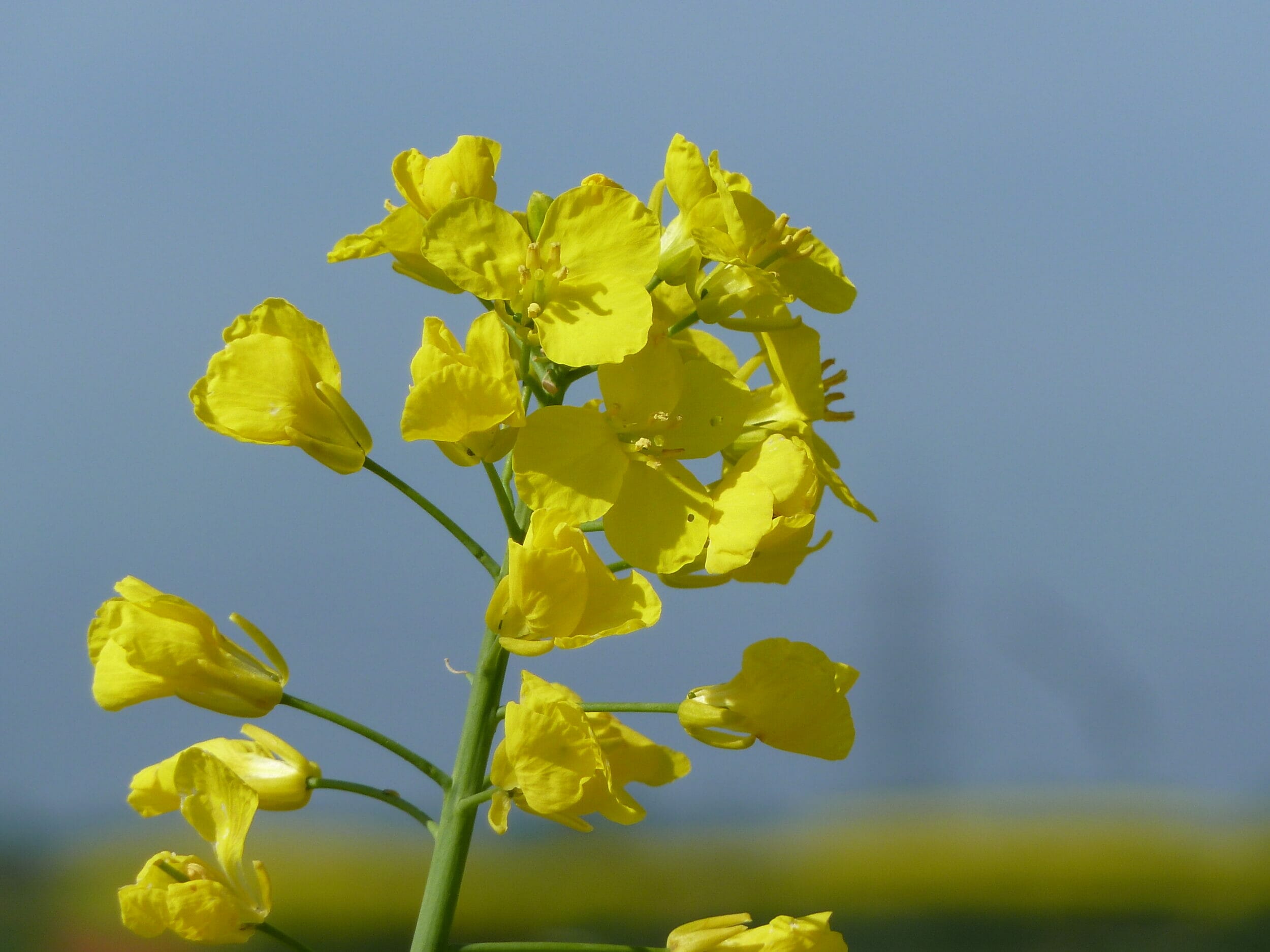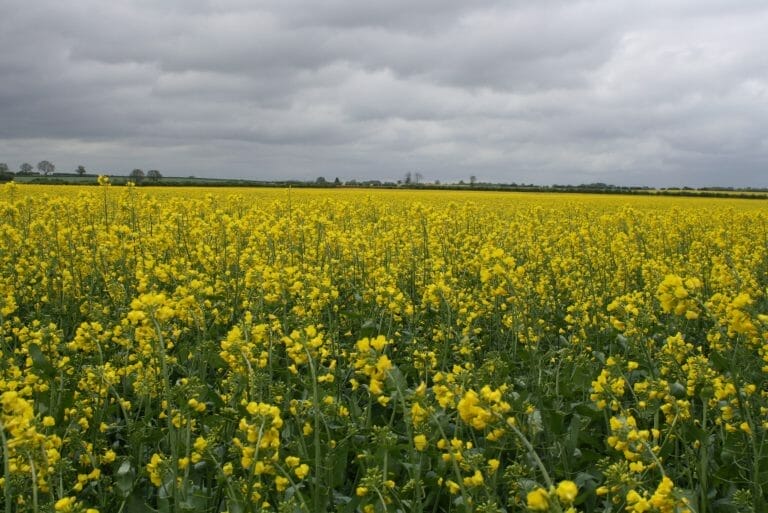“Back in November a meeting was hosted at SRUC, Craibstone to discuss a possible fact-finding visit to Sweden where they grow quite a lot of organic oilseed rape,” explains Andy.
“I decided I would tag along and see if I could get involved. We organised a trip to Linkoping in Sweden, where we visited the Cameleon drill factory and a number of farms over the three days we were there.”
“Once we had seen the crops in Sweden it was clear that growing organic oilseed rape was do-able.” Scotland’s Rural College is leading the Scottish Organic Canola (SCOCAN) project with a £30,000 grant from the Knowledge Transfer and Innovation Fund (KTIF). The project, in turn, follows on from a Rural Innovation Support Service (RISS) group. The project is primarily driven by farmers using a number of approaches, some based around the Swedish model, which include best options for establishing and fertilising the crop, as well as precision weed control.

LG Aurelia
Trials
With guidance from Andy, large plots of oilseed rape have been planted on five farms across the north east of Scotland: one in Moray, three in Aberdeenshire and one in Angus. He reveals attention to detail at every step of the process of preparing, drilling and growing the crop. Key to success of the crop was the correct variety choice; Andy needed a variety with good autumn and spring vigour, and strong agronomic characteristics. He has found just this with winter oilseed rape variety LG Aurelia.
“It was quick to establish last autumn and was quick off the blocks this spring too. It is doing much better than many conventional-grown OSR crops in this area so quite a few farmers in the area have asked us what variety it is – and they wouldn’t believe it was organic,” he says. “I will definitely be growing it again.” LG Aurelia was the variety which stood out for him with its impressive package of genetic traits offering a high gross output and oil yield, Turnip Yellows and pod shatter resistance, along with the best disease resistance package on the 2020/21 AHDB Recommended List – it scores an 8 for Light Leaf Spot and stem canker.
“It’s vigour is noticeable; it has an autumn/spring vigour boost and is medium-early to flower and medium for maturity, ensuring less damage from any late frosts, as well as allowing maximum green leaf canopy duration for maximum yield potential. It has turned out to be perfect for the job,” says Andy.
Two organic crops of LG Aurelia were drilled into land that had been grass for 20 years. Prior to sowing, the grass ley had been disc harrowed at one site, and rotovated at the other to break up the sod before ploughing, as this helps reduce pest numbers and nutrient lock up. “Sowing date for one site was 12 August and we used a seed rate of 55 plants/m2. This was sown with an Amazone 6m power harrow drill combination. We were delighted that within just four or five days the crop emerged and there was little sign of flea beetle.”

Fully loaded Hybrid from LG
Another, on the Moray coast, went in behind carrots. This crop developed roots which measured up to three feet long, he reports. Three of the four sites were sown using the System Cameleon drill. Seed-bed creation is normally done by first ploughing and pressing or ploughing then spade rolling or it can be direct drilled into stubbles using the System Cameleon (a low draft, low disturbance seed drill which is also an inter-row hoe using camera guidance). The bed is normally rolled after sowing and if slugs are likely to be a problem, he applies organic slug pellets with the Cameleon drill. Andy has his own organic starter treatment mixture applied in the seed-bed which helps protect the crop from flea beetle, while a sulphur-based nutrient product helps deter pollen beetles.
Fertiliser is used according to requirement; every field has a Full Soil Survey which uses ADAS and Albrecht figures to determine the soils chemical, physical and biological profile. This analysis can also determine potential nitrogen availability, and any limiting factors. All sites received sulphur- based nutrition at 5-leaf stage and stem extension. Another dose of sulphur based nutrition will be applied once the petals are all off. This is followed up during the season and if necessary sulphur based foliar treatments are applied.
Site Layouts and trials facts:
Site 1:
Near Inverurie, Aberdeenshire: sown 30th September: 2 fields 9.80ha in total
Variety: DLF Elevation (Conventional variety)
Previous crop: Orrganic winter oats (seed)
Cultivations:
Half field ploughed, spade rolled then sown with Cameleon drill at 25cm spacings sown at 5kg/ha to give 12 – 15 plants per linear metre.
Half field direct drilled with Cameleon drill at 25cm spacings sown at 5kg/ha to give 12 – 15 plants per linear metre. This field was not rolled
Also given special organic seedbed mix to help ward off flea beetle.
This site also got inter-row weeded with the Cameleon at 5-leaf stage and the start of stem extension, there was a serious problem with volunteer winter oats from previous crop.
Present crop condition: TOTAL CROP FAILURE
Site 2:
Near Strichen, Aberdeenshire: sown 12th August, one field 5ha in total
Varieties: LG Aurelia, LG Ambassador, LG Artemis, DSV Dazzler, DSV Darling (All Hybrids)
Previous Crop: Grass 20 years plus old
This crop also got 10t/acre hen-pen at stem extension.
Cultivations:
Field given good dose of muck, disced, harrowed in then ploughed and Cambridge rolled then sown with a 6m Lemken power harrow combination drill LG varieties sown at 5kg/ha and DSV at 2.5kg/ha to give 55ppm2 (sown using TGW). This field was never rolled.
Also given special organic seedbed mix to help ward off flea beetle.
Present crop condition: Very Good
Site 3:
Near New Aberdour, Aberdeenshire: sown 1st September: two fields 8.15ha in total
Varieties: LG Aurelia, DMH440(Bayer) (Both Hybrids)
Previous Crop: Grass 20 years plus old
Cultivations:
Field rotovated, ploughed and spade rolled then sown at 25cm spacing at 5kg/ha giving 12 – 15 plants per linear metre. Rolled with Cambridge rollers
Also given special organic seedbed mix to help ward off flea beetle.
This crop also got 10t/acre hen-pen at stem extension.
Present crop condition: Very Good
Site 4:
Near Buckie on the Moray Coast, Aberdeenshire: sown 1st September: one field 4ha in total
Varieties: LG Aurelia (Hybrid)
Previous Crop: Carrots
Cultivations:
Field done with spading machine after carrots, spade rolled then sown with Cameleon drill at 25cm spacing at 5kg/ha giving 12 – 15 plants per linear metre. Rolled with Cambridge rollers. White clover was also sown intra-row in this crop.
Also given special organic seedbed mix to help ward off flea beetle.
Present crop condition: Very Good

LG Ambassador
“All sites got tissue analysis at 5 true leaf stage and stem extension, and any nutrients deficient were applied using foliar treatments on an organic derogation,” says Andy.
“The plan was also to use a new organic fungicide, but with a bit of resistance from one of the certifying bodies it was not cleared for use in time. This was to be used at mid and late flower to reduce the risk of sclerotinia.”
“Luckily nature did a good job by blasting the petals to the ground with wind and rain.”
Sites 2 & 3 got amino acids at 5 leaf stage, these really greened up the crop and going by the tissue analysis did the job they said they would as well. A lot of bio stimulants are classed as “Muck & Magic”, but having used amino acids in both conventional and organic cropping I know they work.
This site also got inter-row weeded with the Cameleon at the start of stem extension.

































